

Some time in the early part
of the sixth century BC, the God of Israel appeared to the Hebrew
prophet Ezekiel in a storm theophany, and commissioned him a
prophet in exile to the peoples of Judah and Israel. In the last
of his many visions of, and from, God, Ezekiel saw, and later
wrote down, specific details concerning the layout of the
eschatological city of God, the Hebrew ![]() , Jehovah-shammah, which is the same as
the New Jerusalem of the Book of Revelation.
, Jehovah-shammah, which is the same as
the New Jerusalem of the Book of Revelation.
The names in the following diagram are those of the twelve tribes of Israel, as enounced by Ezekiel in the last five verses of his eponymous prophetic book (Ezekiel 48:31-35). Using the prophet's specific instructions concerning the final orientation of the twelve tribes, an adaptation of the data through the numbers associated with their names – their characteristic values (hereafter, CVs) – provides a fruitful means of enquiry into earlier numerical and geometrical phenomena established at this website.
(A discussion concerning the orientation of these names may be found here; their orthographies, here; details concerning their conversion to numbers, here; the conversion of Greek names and titles, here; and a statistical background to the phenomenon of the Star, here)

- The sum of the twelve tribes in the Star of Israel is 3182 = 37 x 86
- 86 is the value of the fundamental Hebrew name for God, Elohim (
)
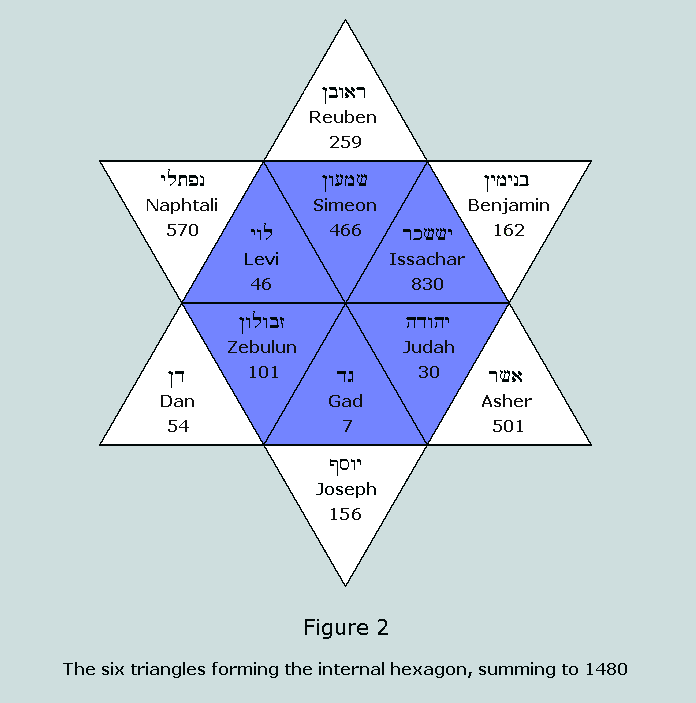
- The six triangles forming the internal hexagon of the Star sum to 1480 = 37 x 40
- 1480 is the value of the Lord's title, Christ (CristoV)
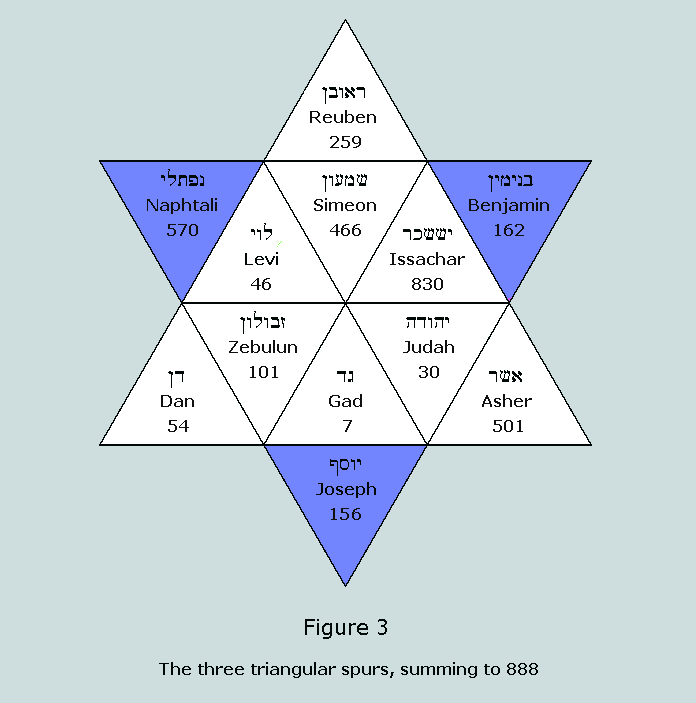
- The three triangular spurs pointing towards the base sum to 888 = 37 x 24
- 888 is the value of the Lord's name, Jesus (IhsouV)
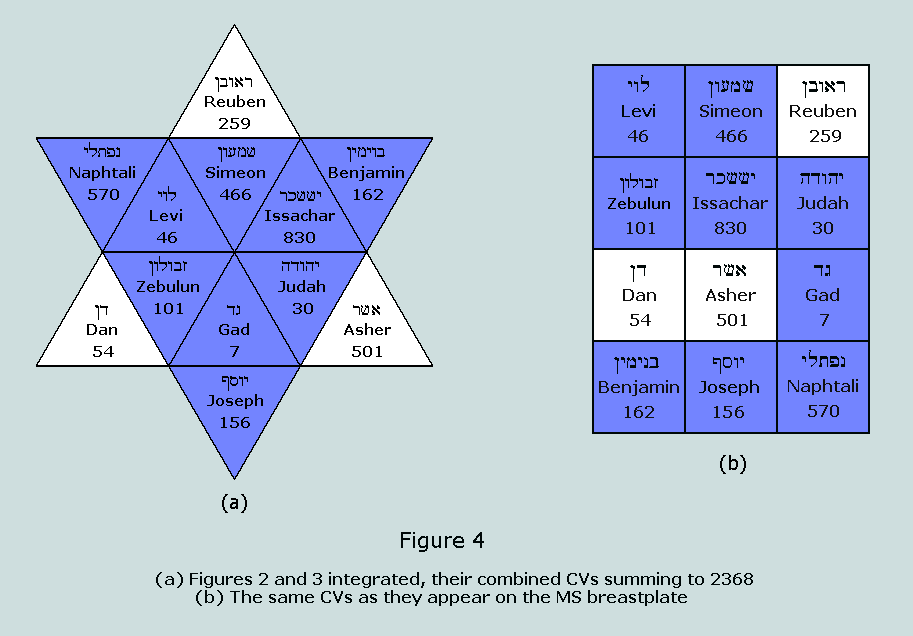
- A union of Figures 2 and 3, as at 4(a), creates a large triangle pointing towards the base of the Star whose combined CVs sum to 2368 = 37 x 64
- 2368 is the value of the Lord's name, Jesus Christ (IhsouV CristoV)
- The same CVs, as they appear on the MS breastplate, as at Figure 4(b), reveal:
(i) The six triangular segments forming the internal hexagon on the Star represent six consecutive CVs on the MS breastplate, from Simeon to Gad, CV2 to CV7, these having a combined value of 1480 = CristoV
(ii) The three triangular spurs on the Star represent three consecutive CVs on the MS breastplate, from Naphtali to Benjamin, CV10 to CV12, these having a combined value of 888 = IhsouV
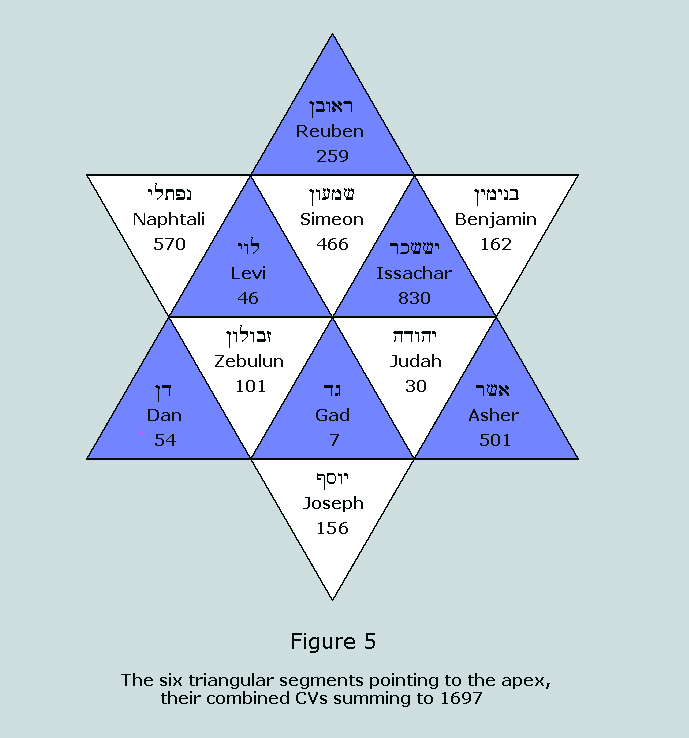
- The six triangular segments pointing towards the apex sum to 1697
- 1697 is the value of the Lord's name, The Word of God (O logoV tou qeou), as revealed at Revelation 19:13
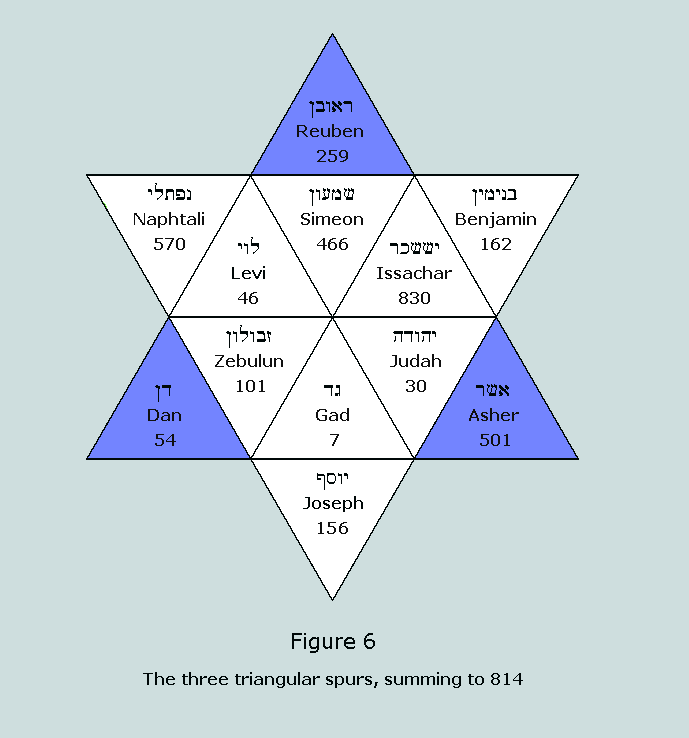
- The three triangular spurs pointing towards the apex sum to 814 = 37 x 22
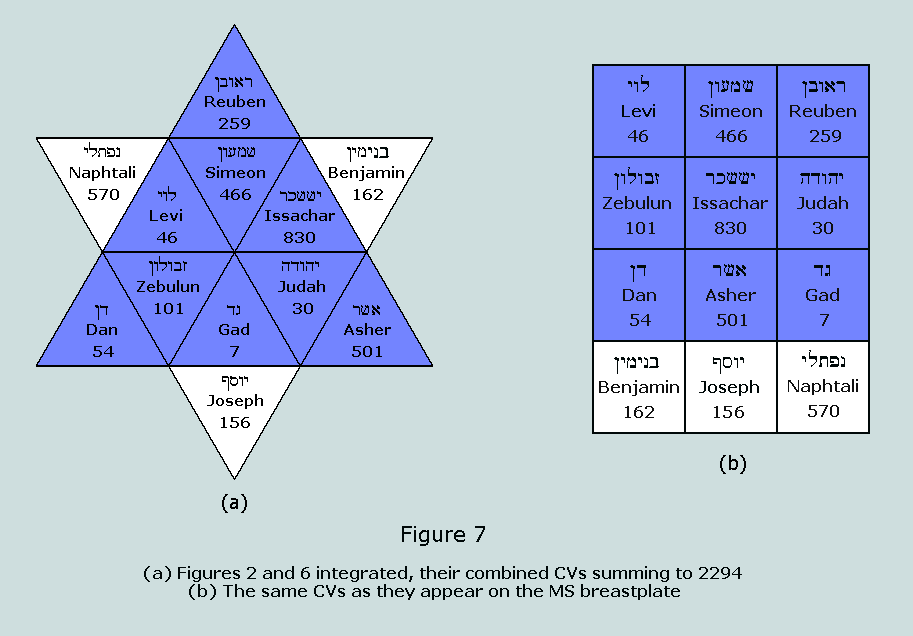
- A union of Figures 2 and 6, as at Figure 7(a), creates a large triangle pointing towards the apex of the Star whose combined CVs sum to 2294 = 37 x 62
- 2294 is the value of Psalm 117, the Bible's central, and shortest, chapter, as evidenced here
- The same CVs, as they appear on the MS breastplate, are found to be consecutive, from Reuben to Dan, CV1 to CV9, and form the first three rows, as at Figure 7(b)
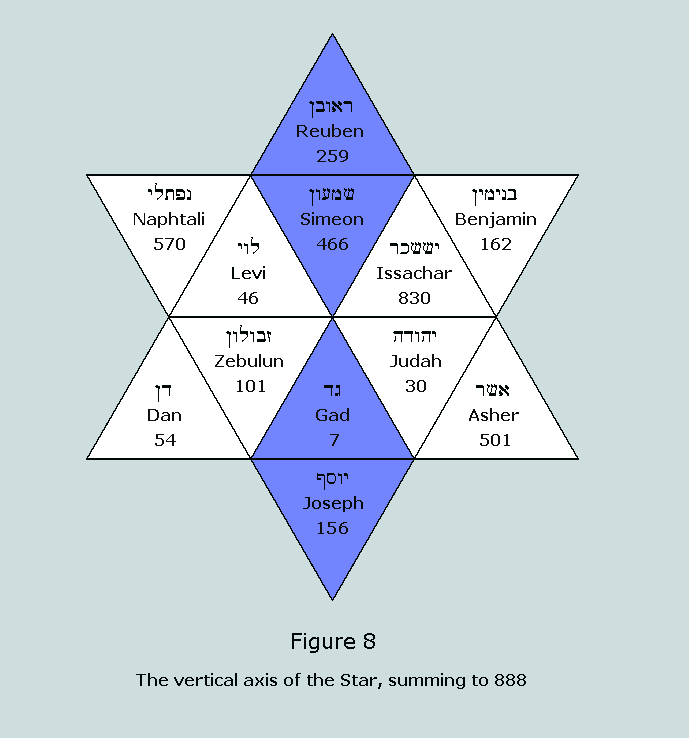
- The four triangular segments forming the vertical axis of the Star sum to 888 = 37 x 24
- As noted earlier, 888 is the CV of the Lord's name, Jesus (IhsouV)
- These four triangular segments represent the leading tribes for each of the four gate structures (see Figure 13(b), Column 1, for details)
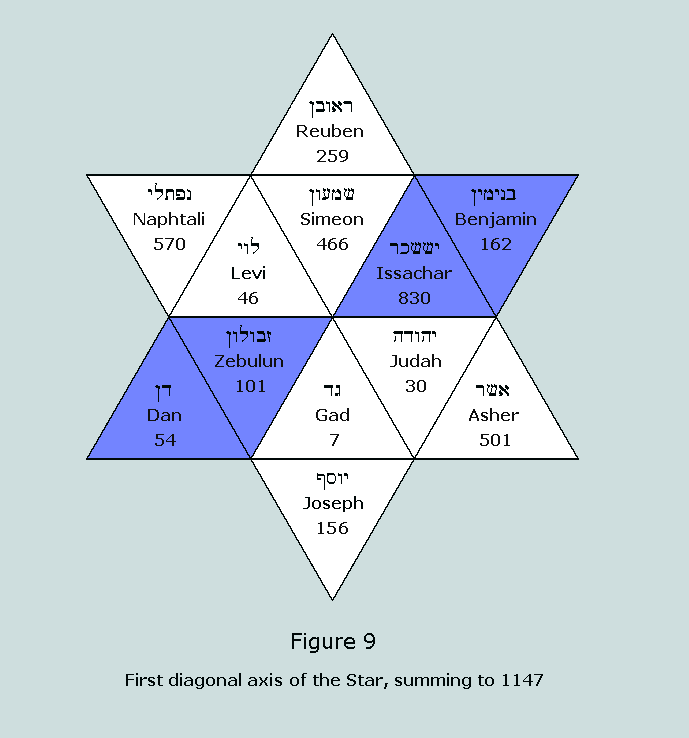
- The four triangular segments forming the first diagonal axis of the Star sum to 1147 = 37 x 31
- 31 is the value of the generic Hebrew word for God, El (
)
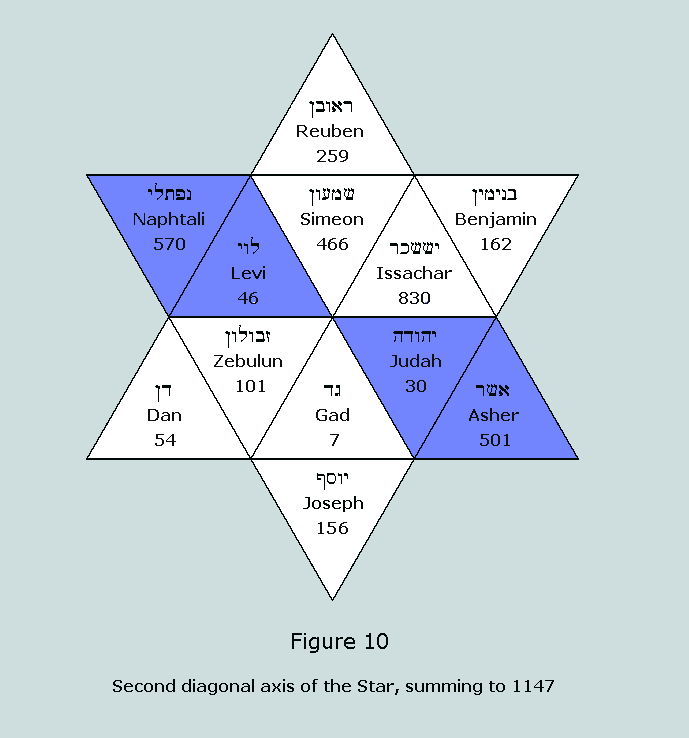
- The four triangular segments forming the second diagonal axis of the Star sum to 1147 = 37 x 31
- The sums of both diagonal axes, at Figure 9 and Figure 10 respectively, are therefore equivalent, and represent, in a compelling manner, an integrated aspect of numero-geometrical symmetry
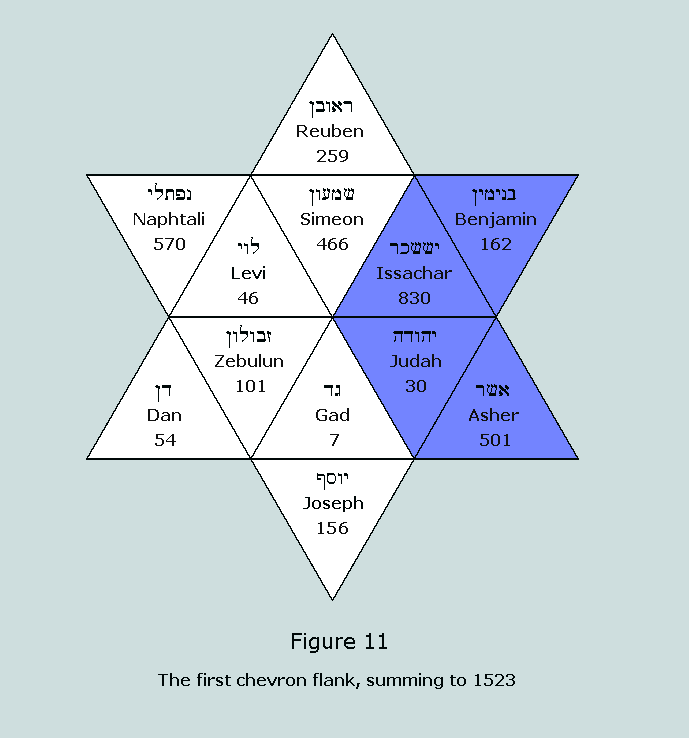
- The four triangular segments forming the first chevron flank sum to 1523
- These are composed of the second, and therefore central, tribes enounced in each of the four triplets for the four gate structures (see Figure 13(b), Column 2, for details)
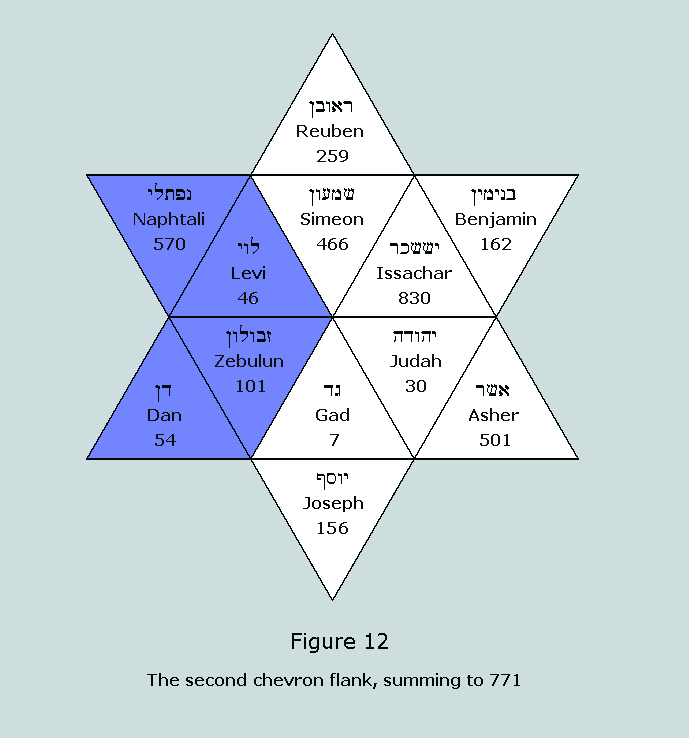
- The four triangular segments forming the second chevron flank sum to 771
- These are composed of the third, and therefore final, tribes enounced in each of the four triplets for the four gate structures (see Figure 13(b), Column 3, for details)
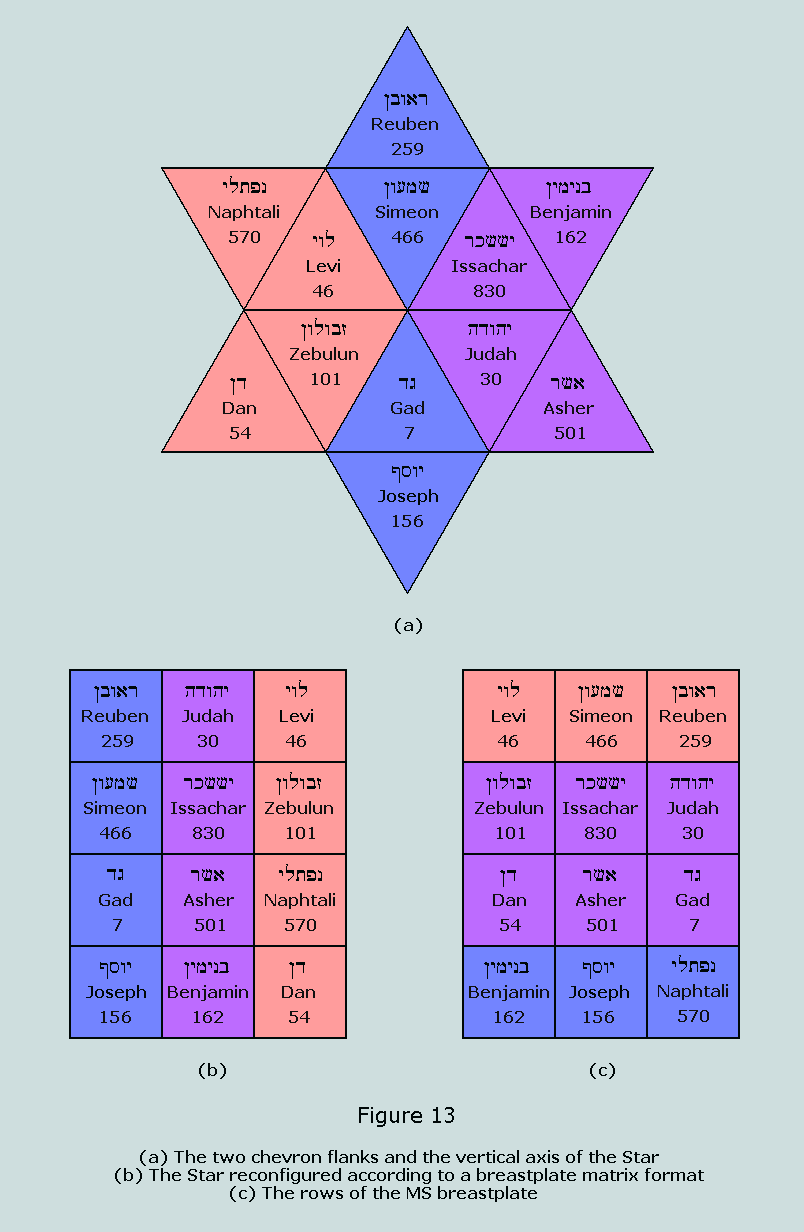
- The sum of the four initial tribes enounced for each of the four gate structures – Figure 13(b), Column 1 - of Ezekiel's visionary city is 888, the same as at Figure 8, and at Figure 13(a) in sky blue
- The sum of the four central tribes enounced for each of the four gate structures – Figure 13(b), Column 2 - is 1523, the same as at Figure 11, and at Figure 13(a) in purple.
- The sum of the four final tribes enounced for each of the four gate structures – Figure 13(b), Column 3 - is 771, the same as at Figure 12, and at Figure 13(a) in pink
- Reconfigured after a breastplate template, it will therefore be observed that the sums for the three Columns in this new Star matrix are: (i) Column 1 = 888, (ii) Column 2 = 1523, and, (iii) Column 3 = 771, as at Figure 13(b)
- The above sums are compared with the MS breastplate matrix at Figure 13(c), where it will be observed that the first row sums to 771, the same value accorded Column 3 of the reconfigured Star matrix; the two central rows sum as 961 + 562 = 1523, the same value accorded Column 2 of the reconfigured Star matrix; and the final row sums to 888, the same value accorded Column 1 of the reconfigured Star matrix
- The parallels between these two separate arrays of the twelve tribes, through the respective sums of their contributing CVs, suggest a common source; this, in spite of the vastly different ordering principles underpinning each matrix
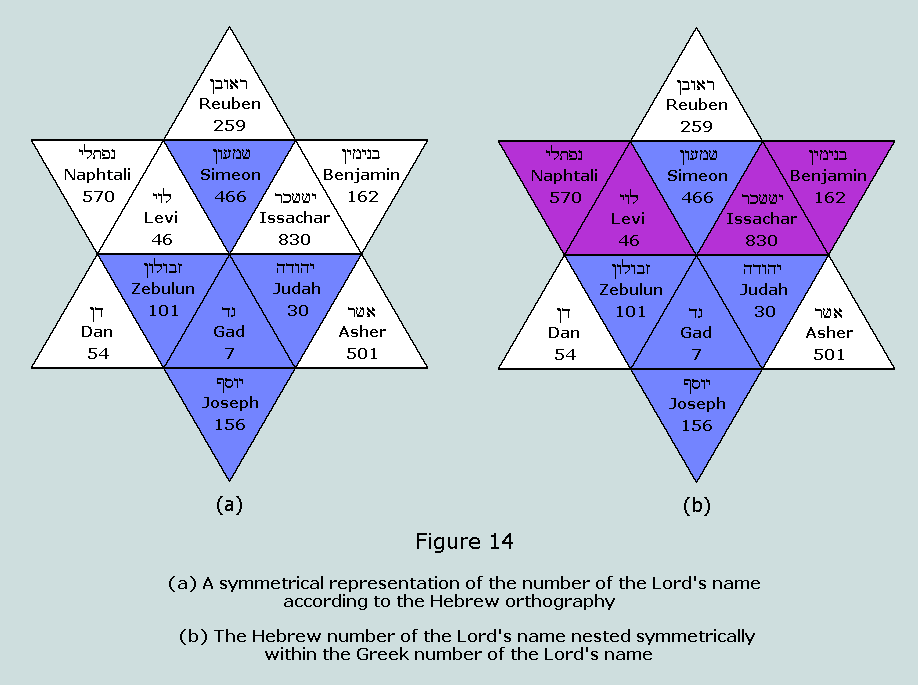
- The five triangular segments in Figure 14(a) sum to 760
- 760 is the value of the Lord's name in Hebrew according to the plene spelling, Jesus Christ (
)
- In Hebrew, Jesus can be spelt in three different ways:
, which has a CV of 397;
, which has a CV of 391; and
, which has a CV of 386. In this instance, the plene spelling, with a CV of 397, applies
- The title
takes the definite article on this occasion
- It will be observed that Figure 14(a) is a subset of Figure 4(a), and nests symmetrically within it, as at Figure 14(b). We thus have a numerical expression of the Hebrew of the Lord's name residing symmetrically within the Greek of the Lord's name
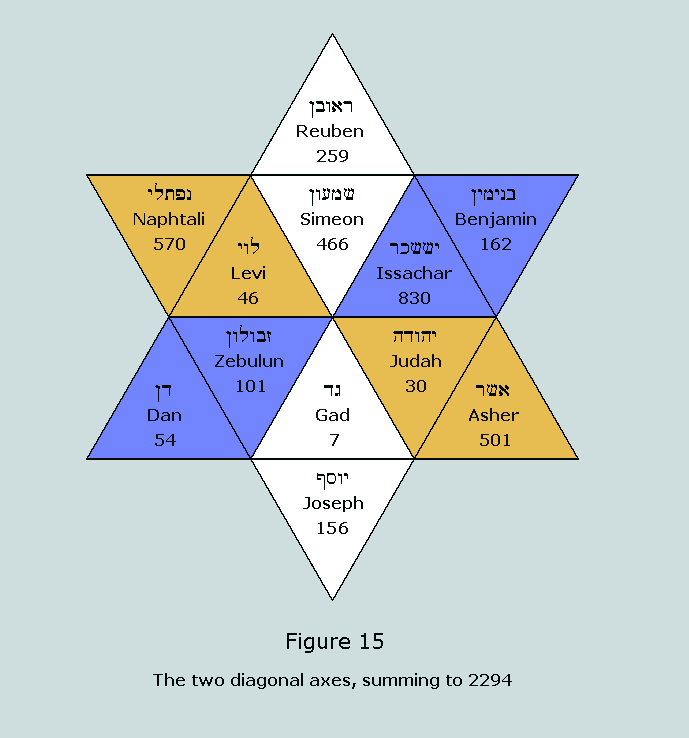
- The two diagonal axes share the same value of 1147, as previously observed at Figure 9 and Figure 10
- Their combined sum of 2294 offers another symmetrical arrangement of this number, the first instance being that at Figure 7(a)
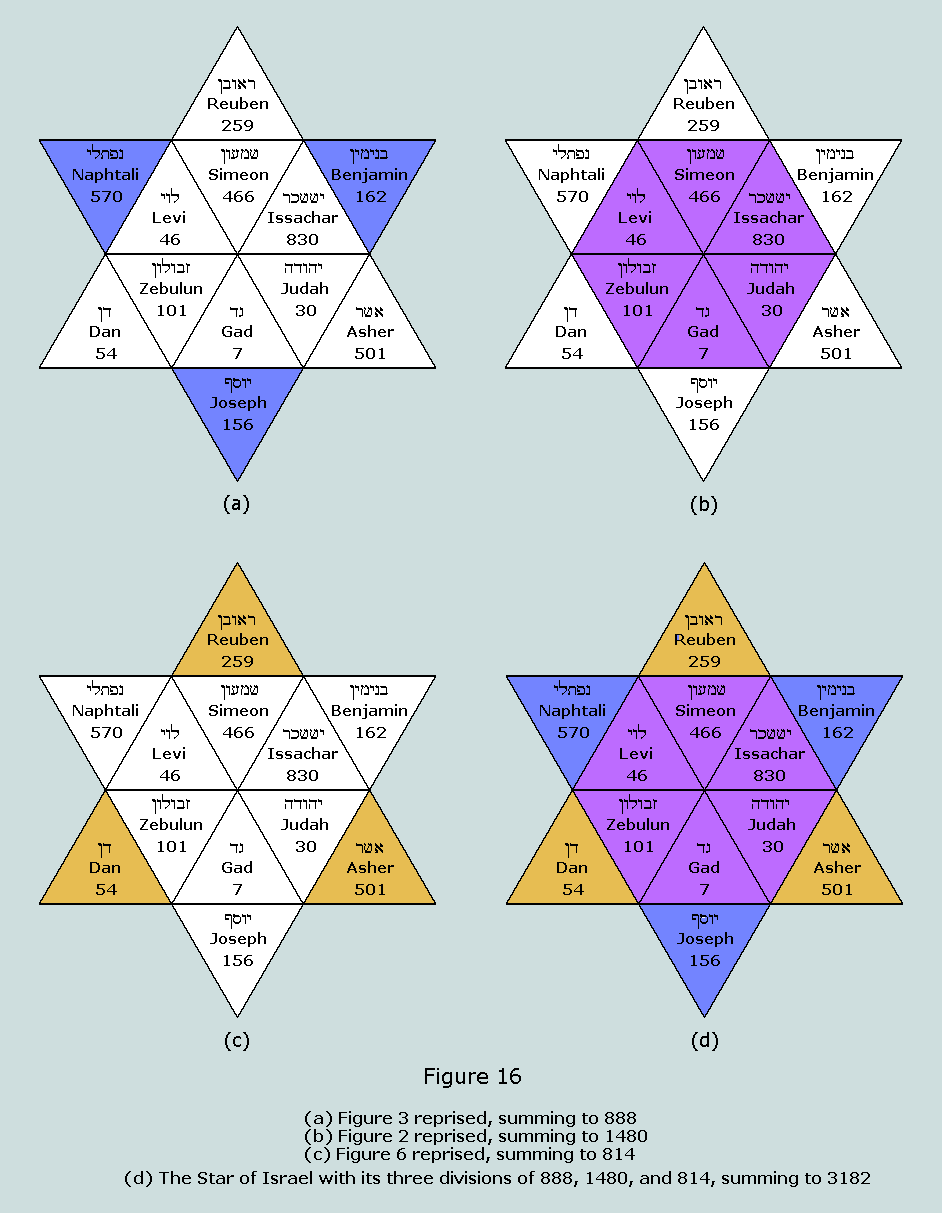
- The four Figures, above, offer a tantalising comparison to Hebrews 13:8, where we read, taking Stephen's Textus Receptus as our Greek reference: IhsouV CristoV cqeV kai shmeron o autoV = "Jesus Christ yesterday and today the same"
- The first three words of Hebrews 13:8 – translated as “Jesus Christ yesterday" - sum as:
(i) IhsouV = Jesus = 888 = Figure 16(a)
(ii) CristoV = Christ = 1480 = Figure 16(b)
(iii) cqeV = yesterday = 814 = Figure 16(c)
(iv) IhsouV + CristoV + cqeV = Jesus + Christ + yesterday
= 888 + 1480 + 814 = 3182 = Figure 16(d)
These details concerning the parallel to Hebrews 13:8 are given further support by an earlier symmetrical configuration involving the numbers of the Lord’s name.
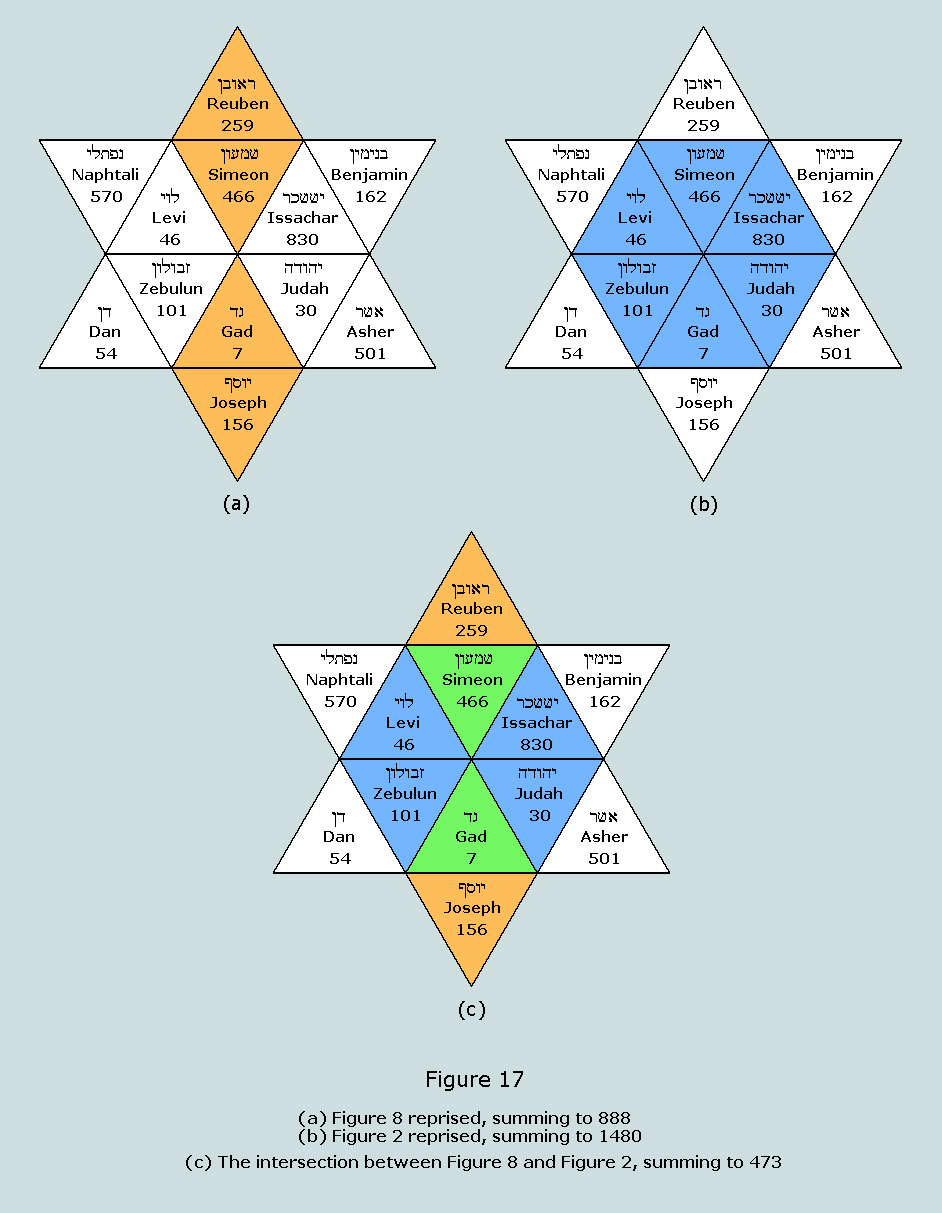
- The three Figures, above, offer further evidence for the comparison to Hebrews 13:8, where we once more rehearse the reading from Stephen’s Textus Receptus:
IhsouV CristoV cqeV kai shmeron o autoV = "Jesus Christ yesterday and today the same"
- Words 1, 2, and 5 of Hebrews 13:8 – translated as “Jesus Christ today” – sum as:
(i) IhsouV = Jesus = 888 = Figure 17(a)
(ii) CristoV = Christ = 1480 = Figure 17(b)
(iii) shmeron = today = 473 = Figure 17(c)
Figures 16(a), (b), (c), and (d), and Figures 17(a), (b), and (c) provide details concerning the parallel between discrete symmetrical arrangements of the Star of Israel on the one hand, and Hebrews 13:8 on the other. These coincide through their respective CVs, testifying to the unique role of Jesus Christ as the Saviour of Israel:
IhsouV CristoV cqeV = "Jesus Christ yesterday" = Figure 16(d)
IhsouV CristoV shmeron = "Jesus Christ today" = Figure 17(c)
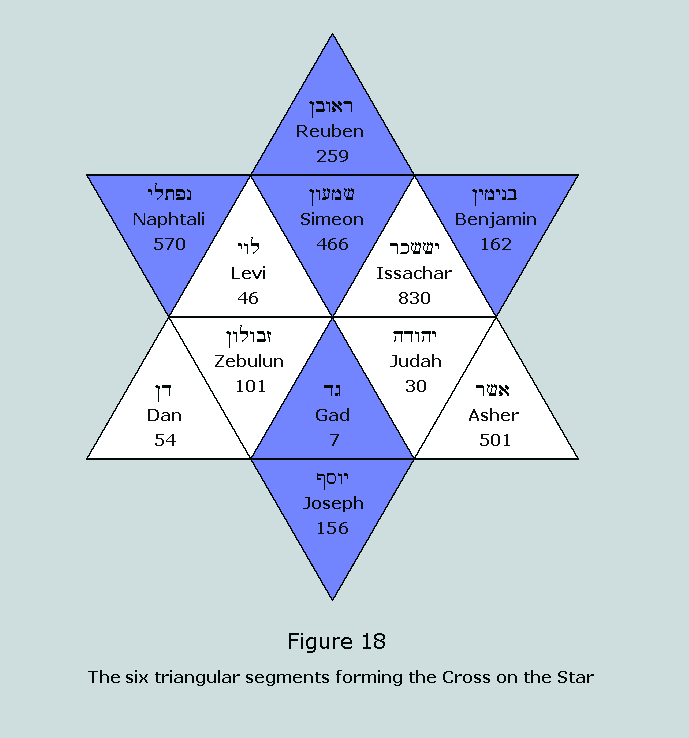
- The six triangular segments in Figure 18 adumbrate a cruciform pattern on the Star
- The vertical axis is the same as that at Figure 8, and sums to 888
- The three triangular spurs pointing to the base are the same as those at Figure 3, and also sum to 888
- The form of the Cross on the Star is thus observed to be a blend of two symmetrical renderings of the number 888, the element common to both being the number at the base, 156
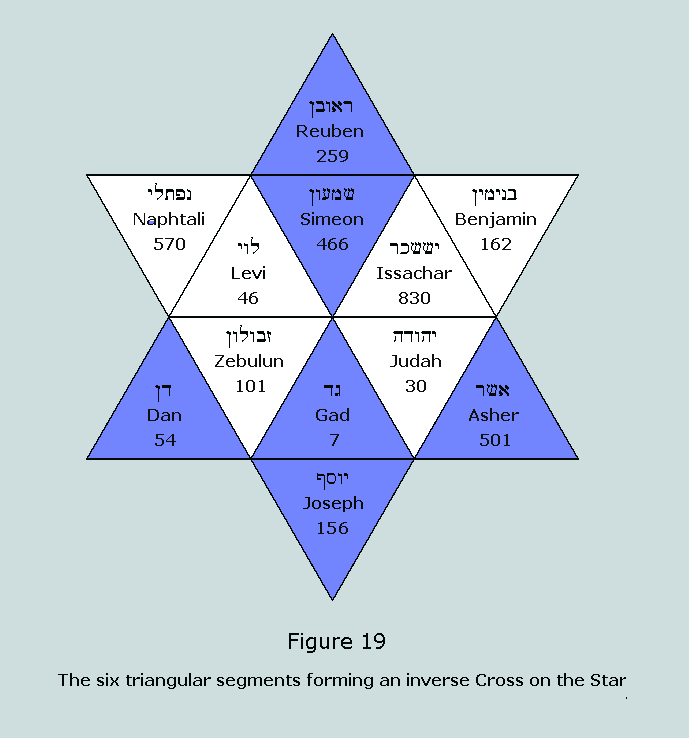
- The six triangular segments in Figure 19 adumbrate a complementary cruciform pattern to that depicted at Figure 18
- The vertical axis is the same as that at Figure 8, and sums to 888 = 37 x 24
- The remaining two spurs sum to 555 = 37 x 15
- The sum of the six constituent CVs is 1443 = 37 x 39
- Figure 18 and Figure 19 are isomorphic to one another through rotation
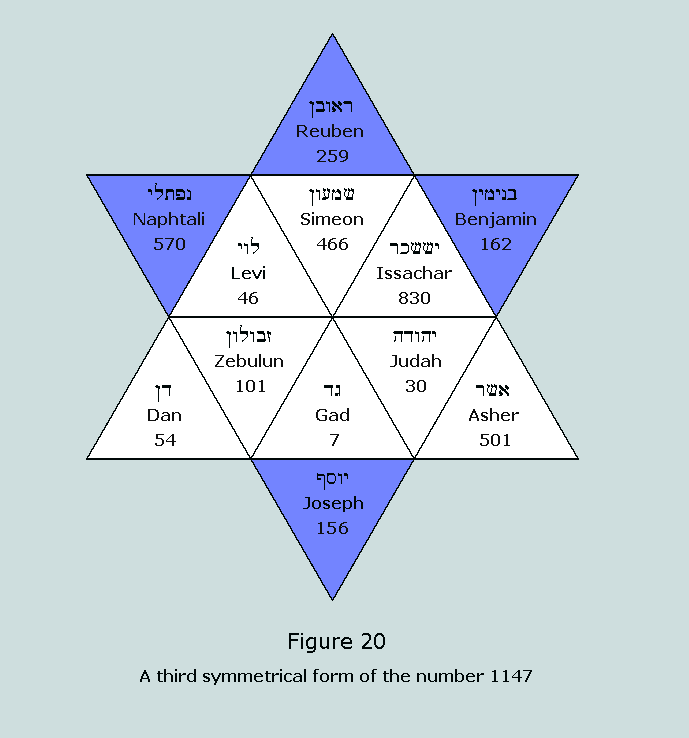
- The four triangular segments in Figure 20 represent the four tips of the Cross at Figure 18
- Their sum is 1147 = 37 x 31, the same sum found for Figure 9 and for Figure 10
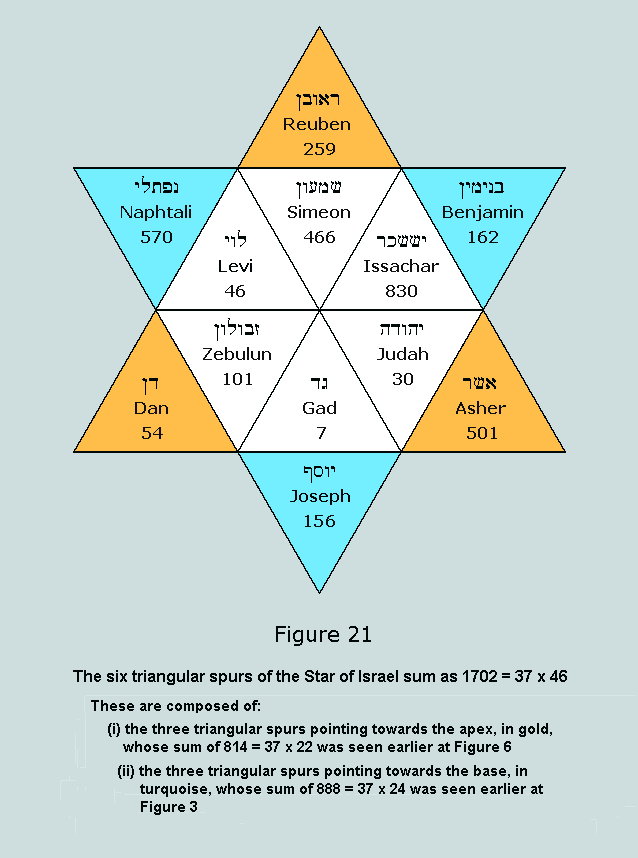
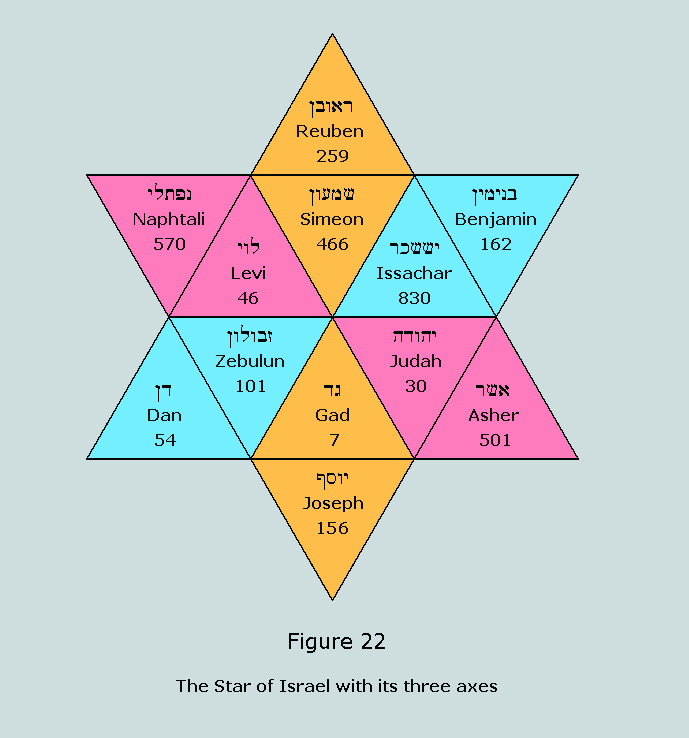
- The final rendition of the Star of Israel is divided according to its three axes
- The first axis is the vertical axis, previously observed at Figure 8, and has a combined CV of 888 = 37 x 24
- The second axis, previously observed at Figure 9, has a combined CV of 1147 = 37 x 31
- The third axis, previously observed at Figure 10, has a combined CV of 1147 = 37 x 31
- The sums of the two diagonal axes are identical, viz. 1147; they differ from the sum of the first axis (888) by 259
- Intriguingly, the leading member of the first axis has a CV of 259, the difference between 1147 and 888
It will be observed that the parallels between the numbers associated with the Star of Israel, and those pertaining to the Lord’s name, exhibit a high degree of coordinated symmetry within the Star matrix. Further symmetrical parallels have been observed by comparing the Star of Israel matrix with that of the MS breastplate.
It will be further demonstrated in Part 2 of this series that compelling parallels exist between the numbers associated with the Star of Israel, and those pertaining to discrete arrangements of the genetic code, as per the nucleon count model set out by shCherbak.
Stephen Coneglan BA
Vernon Jenkins MSc
2010-06-12